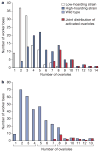Complex social behaviour derived from maternal reproductive traits
- PMID: 16397498
- PMCID: PMC2665028
- DOI: 10.1038/nature04340
Complex social behaviour derived from maternal reproductive traits
Abstract
A fundamental goal of sociobiology is to explain how complex social behaviour evolves, especially in social insects, the exemplars of social living. Although still the subject of much controversy, recent theoretical explanations have focused on the evolutionary origins of worker behaviour (assistance from daughters that remain in the nest and help their mother to reproduce) through expression of maternal care behaviour towards siblings. A key prediction of this evolutionary model is that traits involved in maternal care have been co-opted through heterochronous expression of maternal genes to result in sib-care, the hallmark of highly evolved social life in insects. A coupling of maternal behaviour to reproductive status evolved in solitary insects, and was a ready substrate for the evolution of worker-containing societies. Here we show that division of foraging labour among worker honey bees (Apis mellifera) is linked to the reproductive status of facultatively sterile females. We thereby identify the evolutionary origin of a widely expressed social-insect behavioural syndrome, and provide a direct demonstration of how variation in maternal reproductive traits gives rise to complex social behaviour in non-reproductive helpers.
Figures


Similar articles
-
Effects of selection for honey bee worker reproduction on foraging traits.PLoS Biol. 2008 Mar 4;6(3):e56. doi: 10.1371/journal.pbio.0060056. PLoS Biol. 2008. PMID: 18318602 Free PMC article.
-
8. The development and evolution of division of labor and foraging specialization in a social insect (Apis mellifera L.).Curr Top Dev Biol. 2006;74:253-86. doi: 10.1016/S0070-2153(06)74008-X. Curr Top Dev Biol. 2006. PMID: 16860670 Free PMC article. Review.
-
Support for the reproductive ground plan hypothesis of social evolution and major QTL for ovary traits of Africanized worker honey bees (Apis mellifera L.).BMC Evol Biol. 2011 Apr 13;11:95. doi: 10.1186/1471-2148-11-95. BMC Evol Biol. 2011. PMID: 21489230 Free PMC article.
-
Sensory response system of social behavior tied to female reproductive traits.PLoS One. 2008;3(10):e3397. doi: 10.1371/journal.pone.0003397. Epub 2008 Oct 14. PLoS One. 2008. PMID: 18852894 Free PMC article.
-
Ties between ageing plasticity and reproductive physiology in honey bees (Apis mellifera) reveal a positive relation between fecundity and longevity as consequence of advanced social evolution.Curr Opin Insect Sci. 2016 Aug;16:64-68. doi: 10.1016/j.cois.2016.05.009. Epub 2016 May 20. Curr Opin Insect Sci. 2016. PMID: 27720052 Free PMC article. Review.
Cited by
-
Extended evolution: A conceptual framework for integrating regulatory networks and niche construction.J Exp Zool B Mol Dev Evol. 2015 Nov;324(7):565-77. doi: 10.1002/jez.b.22631. Epub 2015 Jun 11. J Exp Zool B Mol Dev Evol. 2015. PMID: 26097188 Free PMC article.
-
Age at which larvae are orphaned determines their development into typical or rebel workers in the honeybee (Apis mellifera L.).PLoS One. 2015 Apr 16;10(4):e0123404. doi: 10.1371/journal.pone.0123404. eCollection 2015. PLoS One. 2015. PMID: 25880669 Free PMC article.
-
RNAi-mediated double gene knockdown and gustatory perception measurement in honey bees (Apis mellifera).J Vis Exp. 2013 Jul 25;(77):50446. doi: 10.3791/50446. J Vis Exp. 2013. PMID: 23912844 Free PMC article.
-
Genetics of reproduction and regulation of honeybee (Apis mellifera L.) social behavior.Annu Rev Genet. 2012;46:97-119. doi: 10.1146/annurev-genet-110711-155610. Epub 2012 Aug 28. Annu Rev Genet. 2012. PMID: 22934646 Free PMC article.
-
Bumble Bee (Bombus vosnesenskii) Queen Nest Searching Occurs Independent of Ovary Developmental Status.Integr Org Biol. 2022 Feb 11;4(1):obac007. doi: 10.1093/iob/obac007. eCollection 2022. Integr Org Biol. 2022. PMID: 35274079 Free PMC article.
References
-
- Robinson GE, Grozinger CM, Whitfield CW. Sociogenomics: social life in molecular terms. Nature Rev Genet. 2005;6:257–270. - PubMed
-
- West-Eberhard MJ. In: Animal Societies: Theories and Fact. Itô Y, Brown JL, Kikkawa J, editors. Japan Sci. Soc. Press; Tokyo: 1987. pp. 35–51.
-
- West-Eberhard MJ. In: Natural History and Evolution of Paper Wasp. Turillazzi S, West-Eberhard MJ, editors. Oxford Univ. Press; New York: 1996. pp. 290–317.
-
- Linksvayer TA, Wade MJ. The evolutionary origin and elaboration of sociality in the aculeate Hymenoptera: Maternal effects, sib-social effects, and heterochrony. Q Rev Biol. 2005;80:317–336. - PubMed
Publication types
MeSH terms
Grants and funding
LinkOut - more resources
Full Text Sources

